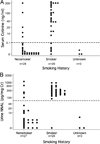Biomarkers increase detection of active smoking and secondhand smoke exposure in critically ill patients
- PMID: 20935560
- PMCID: PMC3148017
- DOI: 10.1097/CCM.0b013e3181fa4196
Biomarkers increase detection of active smoking and secondhand smoke exposure in critically ill patients
Abstract
Objectives: The association between tobacco smoke exposure and critical illness is not well studied, largely because obtaining an accurate smoking history from critically ill patients is difficult. Biomarkers can provide quantitative data on active and secondhand cigarette smoke exposure. We sought to compare cigarette smoke exposure as measured by biomarkers to exposure by self-report in a cohort of critically ill patients and to determine how well biomarkers of cigarette smoke exposure correlate with each other in this population.
Design, setting, and patients: Serum and urine cotinine and trans-3'-hydroxycotinine, urine 4-(methylnitrosamino)-1-(3-pyridyl)-1-butanol, and hair and nail nicotine levels were measured in 60 subjects enrolled in an observational cohort of critically ill subjects at a tertiary academic medical center in Tennessee. Smoking history was obtained from patients, their surrogates, or the medical chart. Cigarette smoke exposure as measured by biomarkers was compared to exposure by history.
Measurements and main results: By smoking history, 29 subjects were identified as smokers, 28 were identified as nonsmokers, and 3 were identified as unknown. The combination of serum cotinine and urine 4-(methylnitrosamino)-1-(3-pyridyl)-1-butanol identified 27 of the 28 nonsmokers by history either as active smokers (n = 6, 21%) or as exposed to secondhand smoke (n = 21, 75%). All biomarker levels were strongly correlated with each other (r = .69-.95, p < .0001).
Conclusions: The combination of serum cotinine and urine 4-(methylnitrosamino)-1-(3-pyridyl)-1-butanol identified considerably more active smokers than did smoking history and detected a high prevalence of secondhand smoke exposure in a critically ill population. These markers will be important for future studies investigating the relationship between active smoking and secondhand smoke exposure and critical illness.
Conflict of interest statement
The authors have not disclosed any potential conflicts of interest.
Figures


Comment in
-
Smoke signals in the intensive care unit.Crit Care Med. 2011 Jan;39(1):197-8. doi: 10.1097/CCM.0b013e3181feb642. Crit Care Med. 2011. PMID: 21178534 No abstract available.
Similar articles
-
Cigarette Smoke Exposure and the Acute Respiratory Distress Syndrome.Crit Care Med. 2015 Sep;43(9):1790-7. doi: 10.1097/CCM.0000000000001089. Crit Care Med. 2015. PMID: 26010690 Free PMC article.
-
Biomarkers of secondhand smoke exposure in automobiles.Tob Control. 2014 Jan;23(1):51-7. doi: 10.1136/tobaccocontrol-2012-050724. Epub 2013 Jan 24. Tob Control. 2014. PMID: 23349229 Free PMC article.
-
Prevalence and impact of active and passive cigarette smoking in acute respiratory distress syndrome.Crit Care Med. 2014 Sep;42(9):2058-68. doi: 10.1097/CCM.0000000000000418. Crit Care Med. 2014. PMID: 24942512 Free PMC article.
-
Methods for quantification of exposure to cigarette smoking and environmental tobacco smoke: focus on developmental toxicology.Ther Drug Monit. 2009 Feb;31(1):14-30. doi: 10.1097/FTD.0b013e3181957a3b. Ther Drug Monit. 2009. PMID: 19125149 Free PMC article. Review.
-
Biomarkers of Exposure to Secondhand and Thirdhand Tobacco Smoke: Recent Advances and Future Perspectives.Int J Environ Res Public Health. 2018 Nov 29;15(12):2693. doi: 10.3390/ijerph15122693. Int J Environ Res Public Health. 2018. PMID: 30501044 Free PMC article. Review.
Cited by
-
Cigarette Smoke Exposure and Acute Respiratory Distress Syndrome in Sepsis: Epidemiology, Clinical Features, and Biologic Markers.Am J Respir Crit Care Med. 2022 Apr 15;205(8):927-935. doi: 10.1164/rccm.202105-1098OC. Am J Respir Crit Care Med. 2022. PMID: 35050845 Free PMC article.
-
Risk factors for the development of acute lung injury in patients with infectious pneumonia.Crit Care. 2012 Dec 12;16(2):R46. doi: 10.1186/cc11247. Crit Care. 2012. PMID: 22417886 Free PMC article.
-
Dysregulated alveolar function and complications in smokers following oesophagectomy.ERJ Open Res. 2019 Mar 4;5(1):00089-2018. doi: 10.1183/23120541.00089-2018. eCollection 2019 Feb. ERJ Open Res. 2019. PMID: 30847351 Free PMC article.
-
The Role of Smoking Status in Making Risk-Informed Diagnostic Decisions in the Lung Cancer Pathway: A Qualitative Study of Health Care Professionals and Patients.Med Decis Making. 2024 Feb;44(2):152-162. doi: 10.1177/0272989X231220954. Epub 2024 Jan 19. Med Decis Making. 2024. PMID: 38240273 Free PMC article.
-
Environmental Factors.Crit Care Clin. 2021 Oct;37(4):717-732. doi: 10.1016/j.ccc.2021.05.002. Crit Care Clin. 2021. PMID: 34548130 Free PMC article. Review.
References
-
- U.S. Department of Health and Human Services. Atlanta, GA: Centers for Disease Control and Prevention, National Center for Chronic Disease Prevention and Health Promotion, Office on Smoking and Health; 2006. The Health Consequences of Involuntary Exposure to Tobacco Smoke: A Report of the Surgeon General, 2006.
-
- U.S. Department of Health and Human Services. Atlanta, GA: Centers for Disease Control and Prevention, National Center for Chronic Disease Prevention and Health Promotion, Office on Smoking and Health; 2004. The Health Consequences of Smoking: A Report of the Surgeon General, 2004.
-
- Flouris AD, Metsios GS, Carrillo AE, et al. Acute and short-term effects of secondhand smoke on lung function and cytokine production. Am J Respir Crit Care Med. 2009;179:1029–1033. - PubMed
-
- World Health Organization. The Tobacco Atlas. [Accessed August 21, 2009];2002 Available at http://www.who.int/tobacco/resources/publications/tobacco_atlas/en/index....
-
- Centers for Disease Control and Prevention. Currrent cigarette smoking among adults ≥18 years—United States, 2009. MMWR Morb Mortal Wkly Rep. 2010;59:1135–1140. - PubMed
Publication types
MeSH terms
Substances
Grants and funding
- HL51856/HL/NHLBI NIH HHS/United States
- HL090833/HL/NHLBI NIH HHS/United States
- KL2 RR024130/RR/NCRR NIH HHS/United States
- P30 DA012393/DA/NIDA NIH HHS/United States
- K24 HL103836/HL/NHLBI NIH HHS/United States
- R25CA113710-03/CA/NCI NIH HHS/United States
- R37 HL051856/HL/NHLBI NIH HHS/United States
- KL2RR024130/RR/NCRR NIH HHS/United States
- R25 CA113710/CA/NCI NIH HHS/United States
- R01 CA078603/CA/NCI NIH HHS/United States
- CA78603/CA/NCI NIH HHS/United States
- R01 HL051856/HL/NHLBI NIH HHS/United States
- U01 HL081332/HL/NHLBI NIH HHS/United States
- HL081332/HL/NHLBI NIH HHS/United States
- K23 HL090833/HL/NHLBI NIH HHS/United States
LinkOut - more resources
Full Text Sources
Medical

